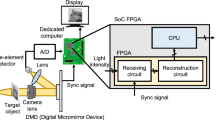Abstract
The Field Programmable Gate Array (FPGA) has been widely used in time-critical tasks such as object detection and tracking. To better accomplish the above tasks, the detection range of the system becomes more and more important. Therefore, a real-time omnidirectional target detection system was carried out. In this system, a dim and small target detection method based on cascaded guided image filter (CGIF) is proposed. Our FPGA-based system shows excellent performance in dim and small target detection with the high detection rate (94%) and the low false alarm rate (5%). First, a target detection algorithm based on cascaded guided image filter is introduced, where the details of large objects can be well suppressed, and the targets are extracted through background suppression and clustering. Second, we design an FPGA-based system, which contains multichannel videos as input through Peripheral Component Interconnect Express (PCIE) interfaces, based on mother-daughter architecture for real-time implementation. Moreover, we also propose a one-line cache display method to exhibit the detection results, which can save much storage space with the same display effect compared with the traditional cache-based scheme. The experimental results show that the proposed system has promising performance and efficiency.
















Similar content being viewed by others
References
Bae TW, Kim YC, Ahn SH, Sohng KI (2009) An efficient two-dimensional least mean square (TDLMS) based on block statistics for small target detection[J]. J Infrared Millimeter Terahertz Waves 30(10):1092–1101
Bai X, Bi Y (2018) Derivative entropy-based contrast measure for infrared small-target detection[J]. IEEE Trans Geosci Rem Sens 56(4):2452–2466
Bai X, Zhou F (2010) Analysis of new top-hat transformation and the application for infrared dim small target detection[J]. Patt Recog 43(6):2145–2156
Cheng K, Yu Y, Zhou H, et al. (2020) GPU fast restoration of non-uniform illumination images[J]. Real-Time Image Proc
Clerentin A, Delahoche L, Brassart E (2000) Cooperation between two omnidirectional perception systems for mobile robot localization[C]. IEEE/RSJ Int Conf Intell Rob Syst 2:1499–1504
Deshpande SD, Er MH, Venkateswarlu R et al (1999) Max-mean and max-median filters for detection of small targets[C]. Sign Data Proc Small Targ 3809:74–83
Farajzadeh M, Mahmoodi A, Arvan M R (2012) Detection of small target based on morphological filters[C]. 20th Iranian Conference on Electrical Engineering (ICEE)
Hagras EAA, Saber M (2020) Low power and high-speed FPGA implementation for 4D memristor chaotic system for image encryption. Multimed Tools Appl 79:23203–23222
Wang H, Dong H, Zhou Z (2019) Review on dim small target detection technologies in infrared single frame images[J]. Laser Optoelectron Progr 56(8):080001
He K, Sun J, Tang X (2013) Guided image filtering[J]. IEEE Trans Softw Eng 35(6):1397–1409
He YJ, Li M, Wei ZH et al (2021) Infrared small target detection based on weighted variation coefficient local contrast measure[C] Chinese conference on pattern recognition and computer vision (PRCV). Springer, Cham, pp 117–127
Henzinger TA, Sifakis J (2006) The embedded systems design challenge[C]. In: 14th International Symposium on Formal Methods, Hamilton 2006:1–15
Jiang J, Liu C, Ling S (2015) An FPGA implementation for real-time edge detection[J]. J Real-Time Image Proc 15:1–11
Masahiko, Y (1998) Omnidirectional Sensing and Combined Multiple Sensing[EB/OL]. Digital Object Identifier 10. 1109 CV-VRHC. 1998–06- 03, 660367
Mittal S (2020) A survey of FPGA-based accelerators for convolutional neural networks[J]. Neural Comput & Applic 32(4):1109–1139
Phadikar A, Mandal H, Chiu TL (2020) A novel QIM data hiding scheme and its hardware implementation using FPGA for quality access control of digital image[J]. Multi Tools Appl 79:12507–12532
Qian K, Zhou H, Qin H et al (2017) Guided filter and convolutional network based tracking for infrared dim moving target[J]. Infr Phys Technol 85:431–442
Rawat SS, Verma SK, Kumar Y (2020) Review on recent development in infrared small target detection algorithms[J]. Proc Comp Sci 167:2496–2505
Shenghui R, Huixin Z, Zhigang W, et al. (2017) An improved non-uniformity correction algorithm and its hardware implementation on FPGA[J]. Infrared Phys Technol: S135044951630696X
Sivaraman R, Rajagopalan S, Amirtharajan R (2020) FPGA based generic RO TRNG architecture for image confusion. Multimed Tools Appl 79:13841–13868
Song S, Zhou H, Yang Y, Song J (2019) Hyperspectral anomaly detection via convolutional neural network and low rank with density-based clustering[J]. IEEE journal of selected topics in applied earth observations and remote sensing, Early Access Article
Wang J, Wang Y, Dang J, et al. (2018) Target detection based on Cascade network and densely connected network in remote sensing image[C] 2018 IEEE 16th Intl Conf on dependable, autonomic and secure computing, 16th Intl Conf on pervasive intelligence and computing, 4th Intl Conf on big data intelligence and computing and cyber science and technology congress. IEEE
Ye B, Peng J (2002) Small target detection method based on morphology top-hat operator[J]. J Image Graph
Zeng M, Li J, Peng Z (2006) The design of top-hat morphological filter and application to infrared target detection[J]. Infr Phys Technol 48(1):67–76
Zhu J, Hu H, Lu D et al (2019) The research on fully FPGA-based real-time simulation with high fidelity and low cost for the cascaded STATCOM[J]. Trans Chin Electrotech Soc 34(4):777–785
Zou T, Zuo Z (2018) Complex background suppression using global-local registration strategy for the detection of small-moving target on moving platform[C] automatic target recognition and navigation
Acknowledgements
This work was supported by Equipment Development Research and Key Laboratory Foundation Project of China(6142107200208) and Equipment Development Research Project of China(61404130316, 61404140506, 61409230214).
Author information
Authors and Affiliations
Corresponding author
Additional information
Publisher’s note
Springer Nature remains neutral with regard to jurisdictional claims in published maps and institutional affiliations.
Rights and permissions
Springer Nature or its licensor (e.g. a society or other partner) holds exclusive rights to this article under a publishing agreement with the author(s) or other rightsholder(s); author self-archiving of the accepted manuscript version of this article is solely governed by the terms of such publishing agreement and applicable law.
About this article
Cite this article
Zhang, Z., Li, H., Yu, Y. et al. A real-time omnidirectional target detection system based on FPGA. Multimed Tools Appl 82, 30929–30947 (2023). https://doi.org/10.1007/s11042-023-14585-w
Received:
Revised:
Accepted:
Published:
Issue Date:
DOI: https://doi.org/10.1007/s11042-023-14585-w




